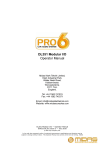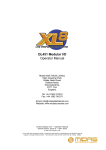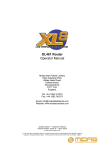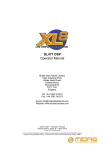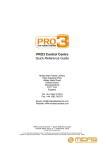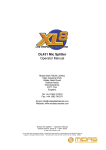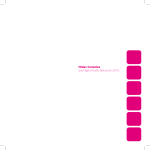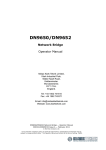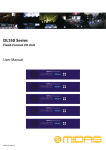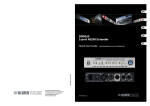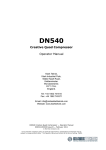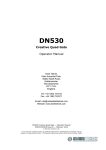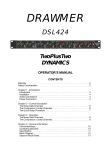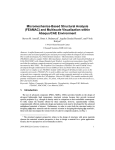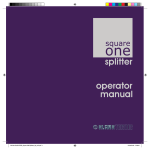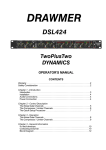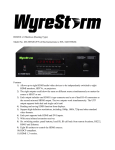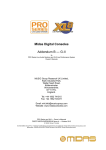Download Midas DL371 Specifications
Transcript
DL371 Audio System Engine Operator Manual Midas Klark Teknik Limited, Klark Industrial Park, Walter Nash Road, Kidderminster. Worcestershire. DY11 7HJ. England. Tel: +44 1562 741515 Fax: +44 1562 745371 Email: [email protected] Website: www.midasconsoles.com DL371 Audio System Engine — Operator Manual DOC02-DL371 Issue C — July 2010 © Red Chip Company Ltd. In line with the company’s policy of continual improvement, specifications and function may be subject to change without notice. This Operator Manual was correct at the time of writing. E&OE. IMPORTANT SAFETY INSTRUCTIONS The lightning flash with arrowhead symbol within an equilateral triangle is intended to alert the user to the presence of uninsulated “dangerous voltage” within the product's enclosure that may be of sufficient magnitude to constitute a risk of electric shock to persons. The exclamation point within an equilateral triangle is intended to alert the user to the presence of important operating and maintenance (servicing) instructions in the literature accompanying the product. 1 Read these instructions. 2 Keep these instructions. 3 Heed all warnings. 4 Follow all instructions. 5 Do not use this apparatus near water. 6 Clean only with a dry cloth. 7 Do not block any of the ventilation openings. Install in accordance with the manufacturer’s instructions. 8 Do not install near any heat sources such as radiators, heat registers, stoves, or other apparatus (including amplifiers) that produce heat. 9 Do not defeat the safety purpose of the polarized or grounding-type plug. A polarized plug has two blades with one wider than the other. A grounding type plug has two blades and a third grounding prong. The wide blade or the third prong are provided for your safety. If the provided plug does not fit into your outlet, consult an electrician for replacement of the obsolete outlet. 10 Protect the power cord from being walked on or pinched particularly at plugs, convenience receptacles and the point where they exit from the apparatus. 11 Only use attachments/accessories specified by the manufacturer. 12 Unplug this apparatus during lightning storms or when unused for long periods of time. 13 Refer all servicing to qualified personnel. Servicing is required when the apparatus has been damaged in any way, such as power-supply cord or plug is damaged, liquid has been spilled or objects have fallen into the apparatus, the apparatus has been exposed to rain or moisture, does not operate normally, or has been dropped. 14 Use the mains plug to disconnect the apparatus from the mains. 15 Warning: To reduce the risk of fire or electric shock, do not expose this apparatus to rain or moisture. 16 Warning: Do not expose this equipment to dripping or splashing and ensure that no objects filled with liquids, such as vases, are placed on the equipment. 17 Warning: The mains plug of the power supply cord shall remain readily operable. Midas EC-Declaration of Conformity The undersigned, representing the following manufacturer Manufacturer: Address: Midas Klark Teknik Ltd. Klark Industrial Park, Walter Nash Road, Kidderminster. Worcestershire. DY11 7HJ. hereby declares that the following product Product Type Number Product Description Nominal Voltage(s) Current* Freq. DL371 Audio System Engine 115V AC 230V AC 2.50A 1.34A 50/60Hz * With five modules fitted. is in conformity with the regulations of the following marked EC-directives and bears the -mark accordingly reference number title 2004/108/EC EMC Directive (EMC) 2006/95/EC Low-Voltage Directive (LVD) The conformity of the product with EC Directives for use in environment E4 is provided by compliance with the following standards: Standards/date: Applied Electrical Safety test standards: reference number EN 60065:2002 title Audio, video and similar electronic apparatus. Safety requirements Applied EMC immunity test standards: Applied EMC emission test standards: ref. no. EN 55103-1:1996 Class A title ref. no. EN 55103-1 Annex A: Radiated magnetic disturbance, 50Hz-50kHz title EN 55103-2:1996 Class A EN 61000-4-2:1995 Electrostatic discharge CISPR 22: Radiated disturbance, 30-1000MHz EN 61000-4-3:1996: Radiated RF disturbance, 80-1000MHz EN 55103-1 Annex E: Conducted disturbance, ac & signal ports EN 55103-2 Annex A: Magnetic LF disturbance, 50Hz–10kHz EN 61000-3-2:2000 Mains harmonics EN 61000-4-4:1995: Fast transient bursts, ac & signal ports EN 61000-3-3:1995 Mains voltage flicker EN 61000-4-5:1995: Surge, ac port EN 61000-4-6:1996: Conducted RF field, ac & signal ports EN 61000-4-11:1994: Mains voltage dips and interruptions Place, date: Kidderminster, UK 14th June 2010 General Manager Printed name: John Oakley DOC04-DL371ECDOC Rev. B AVP, Product Development Printed name: Alex Cooper Licences The following are the license agreements applicable to the Midas Digital Equipment. End-User Licence Agreement for Midas™ and Klark Teknik™ Software IMPORTANT - Please read this document carefully before using this Midas™ or Klark Teknik™ Product. This is an agreement governing your use of software or other machine instructions already installed on this Midas™ or Klark Teknik™ Product, as well as other software that we provide for installation on this Product. The Midas™ or Klark Teknik™ Product will not operate in accordance with its documentation without this software. THIS AGREEMENT ("AGREEMENT" OR "LICENCE") STATES THE TERMS AND CONDITIONS UPON WHICH MIDAS KLARK TEKNIK LIMITED ("COMPANY") OFFERS TO LICENSE THE INSTALLED FIRMWARE, SOFTWARE AND/OR PROGRAMS ("the SOFTWARE") WITH THE MIDAS™ OR KLARK TEKNIK™ CONSOLE OR SIGNAL PROCESSING PRODUCT ("PRODUCT") IN WHICH IT HAS BEEN INSTALLED BY, OR FOR WHICH IT IS PROVIDED BY, THE COMPANY. BY USING THIS PRODUCT YOU WILL BE AGREEING TO BECOME BOUND BY THE TERMS OF THIS LICENCE. IF YOU DO NOT AGREE TO THE TERMS OF THIS LICENCE, DO NOT USE THIS PRODUCT AND PROMPTLY RETURN THE PRODUCT TO THE PLACE WHERE YOU OBTAINED IT FOR A FULL REFUND. You agree to notify any persons whom you permit to operate this Product of the terms of this Licence, and to require them to comply with these terms. The Software is licensed, not sold, to you for use only under the terms of this Licence, and the Company reserves all rights not expressly granted to you. The Company retains ownership of all copies of the Software itself, and all proprietary parts of it, including those stored on or in the Product. 1. Licence: Subject to the terms and conditions of this agreement, the Company grants you, and other persons you permit to operate the Product, a personal, limited, non-exclusive, non-transferable licence to use the Software only on the single Product unit in which it has been installed. 2. Restrictions: (a) The Software, and the accompanying written materials, are copyrighted and contain trade secrets and other proprietary matter, including confidential information relating to the specifications and performance characteristics of this Product. Save for such elements as may be licensed to the Company, as described in paragraph 5, all rights to copyrights, trade marks and trade secrets in the Software, or any modifications to it, are owned by the Company. Unauthorised use or copying of the Company's proprietary Software, or any portion thereof, or copying of those written materials, is prohibited. (b) You may not create, market, distribute, or transfer copies of the Company's proprietary Software, or any part of it, to others, or duplicate, rent, lease or loan that Software, or any part of it, except that you may transfer that Software installed in this Product in conjunction with the sale, transfer, loan, rent or lease of this Product, and subject at all times to this Licence. YOU MAY NOT REVERSE ENGINEER, DECOMPILE, DISASSEMBLE, EXTRACT OR SEPARATE OUT, MODIFY, ADAPT, PORT, OR TRANSLATE THE SOFTWARE, DERIVE THE SOURCE CODE OF THE SOFTWARE OR CREATE DERIVATIVE WORKS BASED ON THE SOFTWARE OR ANY ACCOMPANYING WRITTEN MATERIALS, save as is allowed by licences pertaining to component parts of the Software which are licensed by third parties, as described under paragraph 5, or otherwise by law. (c) In the event you violate any term of this Licence, all rights granted herein will automatically and immediately terminate and you must stop using the Software and destroy any copies of the Software. 3. Limited Warranty: Subject to your installation of any Software updates issued by the Company as described herein, and the condition below, the Company warrants that the Software will operate in compliance with the Software's material specifications and documentation for a period of 90 days from your purchase of this Product. The Software is provided "as is" and the Company does not warrant that the operation of the Software will meet your requirements or operate free from error. To the greatest extent permissible by law, the Company DISCLAIMS ALL WARRANTIES AND CONDITIONS, EITHER EXPRESS OR IMPLIED, INCLUDING THE WARRANTIES OF MERCHANTABILITY, FITNESS FOR A PARTICULAR PURPOSE, NON-INFRINGEMENT OF THIRD PARTY RIGHTS OR CAPABILITY OF CORRECTLY PROCESSING PROVIDING AND/OR RECEIVING DATE INFORMATION. You understand that the Company may update or revise the Software but in so doing incurs no obligation to furnish such updates to you. However, the Company may in its discretion make updates available from time to time upon such terms and conditions as it shall determine. It is a condition of the above warranty that you install any such Software updates, as may be issued from time to time by the Company for the Software, in accordance with the Company's instructions, and if you do not do so such warranty will cease to apply. You may view current Software updates at http://www.klarkteknik.com and http://www.midasconsoles.com. 4. Limited Liability: THE ENTIRE RISK ARISING OUT OF YOUR USE OR PERFORMANCE OF THE SOFTWARE REMAINS WITH YOU. THE LIABILITY OF THE COMPANY FOR ANY CLAIMS ARISING OUT OF THIS LICENCE AND/OR BASED UPON THE SOFTWARE, REGARDLESS OF THE FORM OF ACTION, AND INCLUDING WORK STOPPAGE, PRODUCT FAILURE OF MALFUNCTION OR ANY OTHER COMMERCIAL LOSS OR DAMAGE, SHALL NOT EXCEED THE COST OF THE LICENCE FEE FOR THE SOFTWARE OR THE COST OF THIS PRODUCT. SUBJECT TO THE PROVISIONS OF APPLICABLE LAW, IN NO EVENT SHALL THE COMPANY BE LIABLE FOR ANY LOSS OF DATA, LOST OPPORTUNITY OR PROFITS, COST OF COVER OR SPECIAL, INCIDENTAL, CONSEQUENTIAL, OR INDIRECT DAMAGES, EVEN IF YOU ADVISE THE COMPANY OF THE POSSIBILITY OF SUCH DAMAGES. THIS IS A FUNDAMENTAL TERM OF THIS AGREEMENT AND YOU ACKNOWLEDGE THAT THE AMOUNT YOU PAID FOR THE SOFTWARE AND/OR THE PRODUCT REFLECTS THIS ALLOCATION OF RISK. NOTHING IN THIS PARAGRAPH PURPORTS TO EXCLUDE OR LIMIT THE COMPANY'S LIABILITY FOR DEATH OR PERSONAL INJURY CAUSED BY NEGLIGENCE OR ANY OTHER LIABILITY WHICH CANNOT BE EXCLUDED OR LIMITED BY LAW. 5. Other Third-Party Computer Programs: As referred to herein, the term "Software" refers only to proprietary Midas™ or Klark Teknik™ software, owned by the Company, that has been provided to you for installation on, or already installed in, a Product. In addition to the Software, you may have also been provided, at no additional charge, with a version of the widely-available GNU Linux Operating System, which is a modular operating system made up of hundreds of individual software components, each of which was written, and the copyright and other rights in which are owned individually, by various parties (collectively, "the GNU Linux Programs"). Each component has its own applicable end user licence agreement, and many of these agreements permit you to copy, modify, and redistribute the applicable software, but you must review the on-line documentation that shares a directory or otherwise accompanies each of the GNU Linux Programs provided to you for the specific terms and conditions. Nothing in this Licence limits your rights under, or grants you rights that supersede, the terms of any other applicable end user licence agreement. If you wish to receive a computer-readable copy of the source code for any of the GNU Linux Programs that have been provided with your Midas™ or Klark Teknik™ Product, send a cheque or money order (no cash accepted), your address and [£10.00] to cover the cost of optical media, postage and handling, to: Midas Klark Teknik Limited ATTN: Linux Programs CD for Midas™/Klark Teknik™ Walter Nash Road, Kidderminster. Worcestershire. DY11 7HJ. England. In your request, indicate your Product's name and model number, serial number and version/release information. In your request, also indicate the relevant Software version/release information. This offer, made pursuant to the GNU Linux Programs' end user licence agreements, may expire according to the terms of those agreements, in which case your cheque will be returned to you or destroyed at our option. Please note that the GNU Linux Programs that may be available to you under this offer consists of the GNU Linux Operating System components only and none of the proprietary application software developed by Midas or Klark Teknik is included. Other updated Linux distributions containing application software are widely available from a variety of Internet sources, and are often available at minimal or no cost. 6. Termination: This Licence will terminate immediately if you violate any of the Licence terms. Upon termination you must discontinue use of the Software, and either destroy, erase or return to Company all copies of the Software in your possession, custody or control, including those in or on the Product. 7. General: This Licence constitutes the entire agreement between you and the Company with respect to this Software and, save in the case of fraud, supersedes any other communication (including advertising). Company reserves all rights not expressly granted to you in this licence. If any provision of this Licence is held unenforceable, that provision shall be enforced to the maximum extent permissible so as to give effect the intent of this Licence, and the remainder of this Licence shall continue in full force and effect. This Licence shall be governed by English law and the Courts of England and Wales will have exclusive jurisdiction to hear and decide any dispute concerning it or its formation. No breach by you of any provision of this Licence shall be waived or discharged except with the express written consent of the Company and no failure or delay by the Company to exercise any of its rights under this Licence shall operate as a waiver thereof and no single or partial exercise of any such right shall prevent any other or further exercise of that or any other right. You acknowledge that the Company could be irreparably damaged if the terms of this Licence were not specifically enforced, and agree that the Company may seek appropriate equitable remedies with respect to breaches of this Licence, including injunctive relief, in addition to such other remedies as the Company may otherwise have available to it under applicable laws. GNU General Public License (GPL) For details of the Third Party Software License Attribution, Copyright and Terms and Conditions and Notices, and the GNU LESSER GENERAL PUBLIC LICENSE, see the Midas Digital Equipment GNU General Public License (GPL) Booklet part number DOC04-GPL issue A. xi Precautions Before installing, setting up or operating this equipment make sure you have read and fully understand all of this section and the “IMPORTANT SAFETY INSTRUCTIONS” at the front of this manual. This equipment is supplied by a mains voltage that can cause electric shock injury! The following must be observed in order to maintain safety and electromagnetic compatibility (EMC) performance. Safety warnings Signal 0V is connected internally to the chassis. To completely disconnect this equipment from the AC mains, while observing full safety precautions (see “Power” on page xiii), switch off the D.C. POWER ON switch (above the PSU modules on rear of unit) and then switch off the mains at the mains outlet. Isolate the unit by unplugging the three mains leads from rear panel. To avoid electrical shock do not remove covers. General precautions In the event of ground loop problems, disconnect the signal screen at one end of the connecting cables. Note that this can only be done when the equipment is used within a balanced system. Do not remove, hide or deface any warnings or cautions. Power The power supplies contain LETHAL VOLTAGES greatly in excess of the mains voltage and its rails can produce extremely large currents that could burn out equipment and wiring if shorted. The internal power supplies are of the switch mode type that automatically sense the incoming mains voltage and will work where the nominal voltage is in the range 100VAC to 240VAC. Each mains inlet is to be sourced from its own separate wall-mounted mains outlet socket. Otherwise, their mains sources must be suitably DL371 Audio System Engine Operator Manual distributed so as to meet local safety regulations. A Volex locking type plug is fitted on each supplied mains cable, which plugs into a mains IEC connector on the unit. When fitted properly the Volex plug locks into place, preventing it from working loose, or being inadvertently knocked loose or pulled out. To fit a Volex plug, insert it into the mains IEC connector and push it in until it locks in place. Then, check to make sure it is locked in place. To remove it, release its locking device and then pull it out. When fitting or removing a Volex plug, always hold the plug itself and never use the cable, as this may damage it. When removing the equipment’s electric plugs from the outlets, always hold the plug itself and not the cable. Pulling out the plug by the cable can damage it. Never insert or remove an electric plug with wet hands. Do not connect/disconnect a mains power connector to/from the unit while power is being applied to it. Switch the power off first. Handling the equipment Completely isolate the equipment electrically and disconnect all cables from the equipment before moving it. When lifting or moving the equipment, always take its size and weight into consideration. If necessary, use suitable lifting equipment or transporting gear, or sufficient additional personnel. Do not insert your fingers or hands in any gaps or openings on the equipment, for example, vents. xii Installation Before installing the equipment: • Make sure the equipment is correctly connected to the protective earth conductor of the mains voltage supply of the system installation through the mains leads. • Power to the equipment must be via a fused spur(s). • Power plugs must be inserted in socket outlets provided with protective earth contacts. The electrical supply at the socket outlets must provide appropriate over-current protection. • • Precautions Electrostatic discharge (ESD) precautions Observe full electrostatic discharge (ESD) — also known as “anti-static” — precautions when carrying out procedures in this manual that are accompanied by the ESD Susceptibility Symbol (shown above). This caution symbol shows you that ESD damage may be caused to items unless proper ESD precautions are taken, which include the following practices: • Keep the work area free from plastic, vinyl or styrofoam. Both the mains supply and the quality of earthing must be adequate for the equipment. • Wear an anti-static wrist strap. • Discharge personal static before handling devices. Before connecting up the equipment, check that the mains power supply voltage rating corresponds with the local mains power supply. The rating of the mains power supply voltage is printed on the equipment. • Ground the work surface. • Avoid touching ESD-sensitive devices. Location Ideally a cool area is preferred, away from power distribution equipment or other potential sources of interference. Do not install the equipment in places of poor ventilation. Do not install this equipment in a location subjected to excessive heat, dust or mechanical vibration. Allow for adequate ventilation around the equipment, making sure that its fans and vents are not obstructed. Whenever possible, keep the equipment out of direct sunlight. Do not place the equipment in an unstable condition where it might accidentally fall over. Make sure that the mains voltage and fuse rating information of the equipment will be visible after installation. Audio connections To ensure the correct and reliable operation of your equipment, only high quality, balanced, screened, twisted pair audio cable should be used. XLR connector shells should be of metal construction so that they provide a screen when connected to the control centre and, where appropriate, they should have Pin 1 connected to the cable screen. Radio frequency interference—Class A device This equipment has been tested and found to comply with the limits for a Class A digital device, pursuant to Part 15 of the FCC Rules. These limits are designed to provide reasonable protection against harmful interference when the equipment is operated in a commercial environment. This equipment generates, uses, and can radiate radio frequency energy and, if not installed and used in accordance with the instruction manual, may cause harmful interference to radio communications. Operation of this equipment in a residential area is likely to cause harmful interference in which case the user will be required to correct the interference at his own expense. Electric fields Caution: In accordance with Part 15 of the FCC Rules & Regulations, “… changes or modifications not expressly approved by the party responsible for compliance could void the user's authority to operate the equipment.” Should this product be used in an electromagnetic field that is amplitude modulated by an audio frequency signal (20Hz to 20kHz), the signal to noise ratio may be degraded. Degradation of up to 60dB at a frequency corresponding to the modulation DL371 Audio System Engine Operator Manual xiii Precautions signal may be experienced under extreme conditions (3V/m, 90% modulation). Safety equipment Never remove, for example, covers, housings or any other safety guards. Do not operate the equipment or any of its parts if safety guards are ineffective or their effectiveness has been reduced. DL371 Audio System Engine Operator Manual Optional equipment Unless advised otherwise, optional equipment must only be installed by service personnel and in accordance with the appropriate assembly and usage regulations. Special accessories To comply with part 15 of the FCC Rules, any special accessories (that is, items that cannot be readily obtained from multiple retail outlets) supplied with this equipment must be used with this equipment; do not use any alternatives as they may not fulfil the RF requirement. xiv Precautions DL371 Audio System Engine Operator Manual xv Contents Chapter 1 Introduction . . . . . . . . . . . . . . . . . . . . . . . . . . . . . . . . . 1 Overview . . . . . . . . . . . . Features . . . . . . . . . . . . Warranty and registration About this manual . . . . . Unpacking . . . . . . . . . . . Chapter 2 . . . . . . . . . . . . . . . . . . . . . . . . . . . . . . . . . . . . . . . . . . . . . . . . . . . . . . . . . . . . . . . . . . . . . . . . . . . . . . . . . . . . . . . . . . . . . . . . . . . . . . . . . . . . . . . . . . . . . . . . . . . . . . . . . . . . . . . . . . . . . . . . . . . . . . .1 .2 .2 .3 .3 . . . . . . . . . . . . . . . . . . . . . . . . . . . . . . . . . . . . . . . . . . . . . . . . . . . . . . . . . . . . . . . . . . . . . . . . . . . . . . . . . . . . . . . . . . . . . . . . . . . . . . . . . . . . . . . . . . . . . . . . . . . . . . . . . . . . . . . . . . . . . . . . . . . . . . . . . . . . . . . . . . . . . . . . . . . . . . . . . . . . . . . . . . . . . . . . . . . . . . . . . . . . . . . . . . . . . . . . . . . . . . . . . . . . . . . . . . . . . . . . . . . . . . . . . . . . . . . . . . . . . . . . . . . . . . . . . . . . . . . . . . . . . . . . . . . . . . . . . . . . . . . . . . . . . . . . . . . .5 .6 .6 .6 .6 .7 .7 .7 .7 Rear Panel . . . . . . . . . . . . . . . . . . . . . . . . . . . . . . . . . . 9 Mains input . . . DSP modules . . Connector panel Router panel . . Chapter 4 . . . . . Front Panel. . . . . . . . . . . . . . . . . . . . . . . . . . . . . . . . . . 5 DSP role status panel sync source panel . . . system clock panel . . Ethernet tunnel panel psu panel . . . . . . . . Snake X and Y panel . DSP control panel . . . DSP audio panels . . . AES50 audio panels . Chapter 3 . . . . . . . . . . . . . . . . . . . . . . . . . . . . . . . . . . . . . . . . . . . . . . . . . . . . . . . . . . . . . . . . . . . . . . . . . . . . . . . . . . . . . . . . . . . . . . . . . . . . . . . . . . . . . . . . . . . . . . . . . . . . . . . . . . . . . . . . . . . . . . . . . . . . . . . . . . . . . . 10 . 11 . 12 . 13 Getting Started. . . . . . . . . . . . . . . . . . . . . . . . . . . . . . 15 Connecting up . . . . . . . . . . . . . . . . . . . . . . . . . . . . . . . . . . . . . . . . 15 Powering the unit . . . . . . . . . . . . . . . . . . . . . . . . . . . . . . . . . . . . . . 15 Operation . . . . . . . . . . . . . . . . . . . . . . . . . . . . . . . . . . . . . . . . . . . 16 Appendix A Technical Specification. . . . . . . . . . . . . . . . . . . . . . . . 17 General specifications . . . . . . . . . . . . . . . . . . . . . . . . . . . . . . . . . . . 17 Inputs and outputs . . . . . . . . . . . . . . . . . . . . . . . . . . . . . . . . . . . . . 17 Appendix B Replacing A Module . . . . . . . . . . . . . . . . . . . . . . . . . . 19 Appendix C Service Information . . . . . . . . . . . . . . . . . . . . . . . . . . 21 Routine maintenance . . . Cleaning . . . . . . . . . . . . Voltage rail failure . . . . . Hot unplugging/plugging a Equipment disposal . . . . . DL371 Audio System Engine Operator Manual ......... ......... ......... PSU module ......... .... .... .... ... .... . . . . . . . . . . . . . . . . . . . . . . . . . . . . . . . . . . . . . . . . . . . . . . . . . . . . . . . . . . . . . . . . . . . . . . . . . . . . . . . . . . . . . . . . . . . 21 . 21 . 21 . 22 . 22 xvi Appendix D Contents PRO6 Live Audio System . . . . . . . . . . . . . . . . . . . . . . 23 Standard system configuration . . . . . . . . . . . . . . . . . Applications . . . . . . . . . . . . . . . . . . . . . . . . . . . . . . System components (standard supply) . . . . . . . . . . . FOH and MON . . . . . . . . . . . . . . . . . . . . . . . . . . . . . System buses . . . . . . . . . . . . . . . . . . . . . . . . . . . . . Mix matrix . . . . . . . . . . . . . . . . . . . . . . . . . . . . . . . Processing . . . . . . . . . . . . . . . . . . . . . . . . . . . . . . . Audio physical connections . . . . . . . . . . . . . . . . . . . . Surround capabilities . . . . . . . . . . . . . . . . . . . . . . . . Network . . . . . . . . . . . . . . . . . . . . . . . . . . . . . . . . . Reliability (redundancy) . . . . . . . . . . . . . . . . . . . . . . Control software . . . . . . . . . . . . . . . . . . . . . . . . . . . GUI . . . . . . . . . . . . . . . . . . . . . . . . . . . . . . . . . . . . System card expansion . . . . . . . . . . . . . . . . . . . . . . Console linking . . . . . . . . . . . . . . . . . . . . . . . . . . . . Integration of third party hardware/software . . . . . . . Appendix E .... .... .... .... .... .... .... .... .... .... .... .... .... .... .... .... . . . . . . . . . . . . . . . . . . . . . . . . . . . . . . . . . . . . . . . . . . . . . . . . . . . . . . . . . . . . . . . . . . . . . . . . . . . . . . . . . . . . . . . . . . . . . . . . . . . . . . . . . . . . . . . . .23 .25 .26 .26 .26 .27 .28 .30 .31 .31 .31 .32 .32 .32 .32 .32 Setting Up A PRO6 System . . . . . . . . . . . . . . . . . . . . 35 Initial set-up procedure . . . . . . . . . . . . . . . . . . . . . . . . . . Unpacking the equipment . . . . . . . . . . . . . . . . . . . . . . . . . Making up a rack . . . . . . . . . . . . . . . . . . . . . . . . . . . . . . . Wiring instructions . . . . . . . . . . . . . . . . . . . . . . . . . . . . . Powering the PRO6 system . . . . . . . . . . . . . . . . . . . . . . . . Switching the PRO6 Control Centre on/off . . . . . . . . . . . . . Setting up the DL351 Modular I/O unit ID . . . . . . . . . . . . . .. .. .. .. .. .. .. . . . . . . . . . . . . . . . . . . . . . . . . . . . . . . . . . . . .35 .35 .35 .35 .37 .38 .39 DL371 Audio System Engine Operator Manual 1 Chapter 1: Introduction Thank you for purchasing a Midas DL371 Audio System Engine. Your DL371 Audio System Engine was conceived by Midas to offer audio professionals high-performance audio equipment, designed to provide no-compromise sonic quality with a feature set that offers all essential facilities and functions. It represents the very best of British design and engineering combined with contemporary, efficient manufacturing methods, and will give you many years of reliable service. So, to obtain the best results with a minimum of effort, please read this operator manual and, finally, enjoy your Midas DL371 Audio System Engine! Overview The DL371 Audio System Engine (and router) is of user-configurable sub-modular construction and provides power and interconnection for up to seven DSP cards and a router card (dual width). The DL371 Audio System Engine is housed in a 7U, 19” rack mount box. Front panel Rear panel (standard configuration) Each DSP module contains enough digital signal processing power to produce 24 channels of audio EQ and dynamic processing (or to mix down all the console buses and similar etc.). Only five DSP modules are required for the PRO6. The rack can be optionally populated to incorporate an N+1 topology. The router module is the heart of the console’s signal routing network and provides ports for the main and supplementary I/O racks, and the long haul digital snake from stage to front of house. DL371 Audio System Engine Operator Manual 2 Chapter 1: Introduction Features The DL371 Audio System Engine has the following features: • The front panel consists of various LED-only sections that provide status information. • Sub-modular construction provides user-configurable 7 x 24-channel format. • Each module has remote interrogate LEDs for DSP control and analogue and digital audio for health and connection status feedback. • A diagnostics 9-way D-type connector per DSP module provides access to its software for diagnosis, troubleshooting etc. • Eight AES50 24-wide bi-directional digital audio EtherCon® ports are provided, four to allow N+1 connection of the main 64-way I/O rack and four to allow dual redundant connection of DL451 Modular I/O (24-way I/O) units or a second 64-way I/O rack1. • Dual redundant (gigabit) Hyper-MAC 192-wide bi-directional digital audio ports link the router to the control centre on either 150 m fibre or 100 m ruggedised Cat5E2 cables, both of which use Neutrik connectors. • For synchronisation to external systems there are two BNC Clock ports and two XLR digital audio reference signal (DARS) ports. Both sets of ports have one in and one out port. • A 100Mbs Ethernet control port (on EtherCon®) allows a ‘tunnel’ connection to external non-Midas equipment via the control surface. • The unit offers the facility of universal input, N+1 redundant power supplies with 3 latching mains connectors. • The unit is force air cooled by means of 80 mm fans. These produce low noise, which is suitable for concert sound. However, racking in separate “amp rooms” is advised for theatre use. Warranty and registration Midas has total confidence in the quality and reliability of this product. To back this up, this product comes with the standard Midas and Klark Teknik three year warranty. Please take the time to register your product by completing and returning the registration card or registering on our website at www.midasconsoles.com. 1. Neither the 64-way I/O rack or the DL451 Modular I/O are included in the standard (supply) specification of the PRO6. 2. The Cat5E cables supplied are a proven tested solution, but Cat6 can also be used for installations etc. DL371 Audio System Engine Operator Manual About this manual 3 About this manual This is the operation manual for the DL371 Audio System Engine. It is intended to help get your DL371 Audio System Engine installed and in operation as quickly as possible by giving you unpacking, installation, connection, setting up and operating instructions. To help familiarise you with the DL371 Audio System Engine there is a description of the front and rear panels, along with easy-to-follow user instructions. This manual is aimed at professionals, such as front of house (FOH) and monitor (MON) engineers who will be using this equipment in a live performance environment. It is assumed that the reader has prior experience of using professional audio equipment and has, most likely, undergone training on this system. Details in this manual, such as configuration, setting up, connecting up etc., refer only to the unit connected in a standard PRO6 Live Performance System. Should you wish to connect this unit in any other configuration, contact Midas Technical Support for details. The appendices include a brief overview of the PRO6 Live Performance System. However, if you want to learn more about the PRO6 Live Performance System, please go on to read its owner’s manual (part number DOC02-DL3), which provides a full and comprehensive guide. Unpacking Carefully unpack your DL371 Audio System Engine equipment package. Inspect the DL371 Audio System Engine unit carefully for any signs of damage that may have occurred during transit and notify the courier immediately if any is discovered. Check the contents of your DL371 Audio System Engine equipment package and, if there are any parts missing, incorrect or faulty, please contact your local distributor or Midas at the address shown in the front of this manual. Please retain the original packing in case you should need to return the equipment to the manufacturer or supplier, or transport or ship the unit later. DL371 Audio System Engine Operator Manual 4 Chapter 1: Introduction DL371 Audio System Engine Operator Manual 5 Chapter 2: Front Panel The front panel of the DL351 Modular I/O comprises the following: 5 6 7 8 9 10 4 3 2 1 11 1 DSP role status panel; see “DSP role status panel” on page 5. 7 2 sync source panel; see “sync source panel” on page 6. 8 3 system clock panel; see “system clock panel” on page 6. 9 AES50 audio panel; see “AES50 audio panels” on page 7. 4 Ethernet tunnel panel; see “Ethernet tunnel panel” on page 6. 10 Cut-outs for rack mounting fixings. 5 obstruct. psu source panel; see “psu panel” on page 6. DSP control panel; see “DSP control panel” on page 7. DSP audio panel; see “DSP audio panels” on page 7. 11 Four ventilation panels. Do not 6 snake X and Y panel; see “Snake X and Y panel” on page 7. DSP role status panel The DSP role status panel has seven sets of LEDs, one per module, for monitoring their module’s communication status. Each set comprises a green ok LED and a red mute LED, which indicate the following: • ok LED constantly on = module is receiving control updates from the control centre. • mute LED constantly on = role is muted/error condition. On the PRO6 Control Centre, check the Diagnostics screen (GUI menu) for further status information. (The mute LEDs will illuminate briefly as the role starts.) DL371 Audio System Engine Operator Manual 6 Chapter 2: Front Panel sync source panel This has three LEDs, one of which illuminates to indicate the source of the clock as follows: • internal - clock is sourced internally to the router. • external (Word) — clock is sourced from the word clock connector on the rear panel of the router at 96kHz; see “Connector panel” on page 12. • external (AES3) — clock is sourced from the AES3 connectors on the rear panel of the router at 96kHz; see “Connector panel” on page 12. system clock panel This panel has a master and a slave LED, one of which will illuminate to indicate whether the router is audio synchronisation master or slave. Ethernet tunnel panel The Ethernet control panel has a green LED, which has three states of illumination to indicate the following: • Off = not connected. • On = connected. • Flashing = active. psu panel This panel monitors the three supply voltages and the three voltage rails. Each of the three LEDs in the top row represents a PSU. They illuminate when their respective PSU is supplying power to the unit after it has been switched on via the D.C. POWER ON switch. During operation, at least two of the PSUs must be supplying power to the unit. psu section (front panel) Rear panel of DL371 Audio Voltage rails The bottom row of LEDs represent the three voltage rails (+5V, +3.3V, and +12V), which are common to each PSU. The LEDs illuminate to show that their respective rail is live. When the unit is powered, all three LEDs should be illuminated; if not, see “Voltage rail failure” on page 21. DL371 Audio System Engine Operator Manual Snake X and Y panel Snake X and Y panel The snake panel monitors the communications on the copper/optical cabling for both the X and Y networks. Each cable type has an ok and an error LED for communication status indication, as follows: • The ok LED (green) pulsates when the link is synchronised between the router and end point. • The error LED (red) illuminates when either no communications or a fault are detected. DSP control panel The control panel has seven LEDs (green) that indicate the Ethernet control activity and link status of each fitted module, as follows: • Constantly illuminated = linked. • Flashing = data activity (communication is good). • Extinguished = bad/no module fitted. DSP audio panels There are two DSP audio panels, ring 0 and ring 1, that indicate communication status of the DL371A modules. There are seven sets of LEDs in each panel (one per module) comprising an ok LED and an error LED, which indicate the following: • Green ok LED illuminated = communication is good. • Green ok LED extinguished = bad/no module fitted. • Red error LED illuminated = communication error. AES50 audio panels There are two AES50 audio panels, internal and external, that indicate communication status of the AES50 audio connections. There are seven sets of LEDs in each panel (one per module) comprising an ok LED and an error LED, which indicate the following: • Green ok LED pulsating = communication is good. • Green ok LED (internal only) extinguished = bad/no module fitted. • Red error LED illuminated = communication error. DL371 Audio System Engine Operator Manual 7 8 Chapter 2: Front Panel DL371 Audio System Engine Operator Manual 9 Chapter 3: Rear Panel The rear panel of the DL371 Audio System Engine has three main sections, as shown below. 2 3 4 1 1 Mains power sockets and DC isolator switch; see “Mains input” on page 10. 3 2 4 User-configurable module panel; see “DSP modules” on page 11 for module description. (The above diagram shows the default configuration.) DL371 Audio System Engine Operator Manual Connector panel; see “Connector panel” on page 12. Router panel; see “Router panel” on page 13. 10 Chapter 3: Rear Panel Mains input WARNING! HIGH INRUSH CURRENT. Caution: You must ensure that a minimum of two PSU modules are powering the unit for correct operation (see “Switching the PRO6 Control Centre on/off” on page 52). The mains input section comprises three modular sets of mains input and fan assemblies — known as power supply unit (PSU) modules — and a DC isolator switch. The modules are N+1 redundant and a minimum of two must be used to power the unit. Each PSU module comprises a single chassis that slides in and out of the unit to facilitate easy replacement. 5 Note: This diagram does not show the bar across the D.C. POWER ON switch, which helps to prevent accidental operation of the switch, and the securing brackets to the left of each PSU module. 2 1 1 3 4 6 1 Fan outlet vent. 2 Handle for mains input and fan assembly removal. 3 4 Mains IEC socket. Power on/off indicator LED. This has the same functionality as the power supply LEDs in the psu section of the front panel (see “psu panel” on page 6). 5 D.C. POWER ON switch, switches the power to the unit on/off. 6 Mains IEC connector (locking type). This connector has a catch on the side that holds the connector in place when it is inserted in the mains socket. The catch has be pressed to release it before the mains IEC connector can be removed from the socket. DL371 Audio System Engine Operator Manual 11 DSP modules DSP modules Seven module slots in the rear panel each accept the following module. However, in the standard PRO6 configuration, only five modules are fitted to the DL371 Audio System Engine. 1 7 2 4 3 5 8 6 1 DSP audio sections 0 and 1 with two sets of LEDs (link and data) for status indication. 2 Link ok LED (green) illuminates to indicate that link is active (link is good). 3 Link error LED (green) illuminates to indicate that link has failed. 4 Data ok LED (red) illuminates to indicate valid audio and valid aux data (data is good). 5 Data error LED (red) illuminates to indicate there is no audio. 6 DSP control section has the same functionality as the one on the front panel (see “DSP control panel” on page 7). 7 AES50 audio section, has the same functionality as the AES50 audio - internal section of the front panel (see “AES50 audio panels” on page 7). 8 diagnostics 9-way D-type connector socket (female). For use by service personnel only. The modules are numbered as shown in the following diagram. 7 6 5 4 3 2 1 DL371 Audio System Engine Operator Manual 12 Chapter 3: Rear Panel Connector panel The connector panel houses the snake connectors (to console) and the word clock and AES3 sync connectors for connecting the user-selected clock source for synchronisation. 3 4 5 1 2 1 2 CLOCK SOURCE 1 optical Neutrik OpticalCon® snake X and Y sockets for connecting the optical (fibre optic) snake to the console. word clock 75R section comprises input and output BNC cable sockets for synchronisation with routers. 2 4 copper Neutrik EtherCon® snake X and Y sockets for connecting the copper snake to the console. 3 AES3 sync section comprising input (female) and output (male) XLR chassis connectors. DL371 Audio System Engine Operator Manual 13 Router panel Router panel The router panel houses the AES50 audio connectors and Ethernet tunnel connector. DL351 Modular I/O Connection to AES50 audio connectors 5 to 8 is optional 1 1 Ethernet tunnel external connector for connecting ‘tunnelling’ Ethernet. DL371 Audio System Engine Operator Manual 2 2 AES50 audio section with eight EtherCon® sockets. Sockets 1 to 4 are for connection to the DL351 Modular I/O, while the remaining four (sockets 5 to 8) are optional. 14 Chapter 3: Rear Panel DL371 Audio System Engine Operator Manual 15 Chapter 4: Getting Started This chapter shows you how to connect up and switch on the DL371 Audio System Engine unit. Connecting up Refer to Figure 2 “Standard system configuration” on page 50. Connect up the your DL371 Audio System Engine unit as follows: • Snake — connect the two fibre optic/copper snakes to the required X and Y sockets on the rear panel of the DL371 Audio System Engine unit and then to the rear of the PRO6 Control Centre. See “Connector panel” on page 12. • AES50 — connect the four AES50 audio sockets (1 to 4) on the rear panel of the DL371 Audio System Engine unit to the corresponding AES50 audio sockets on the rear panel of the DL351 Modular I/O unit. See “Router panel” on page 13. • Synchronisation (optional) — connect the word clock or AES3 sync connectors to the required clock source. • Mains power supply — connect the mains cables. See “Powering the unit” on page 15. Powering the unit This section shows you how apply power to the unit, and also how to completely isolate the unit electrically. Caution: You must ensure that a minimum of two power supply modules are powering the unit for correct operation (see “Switching the PRO6 Control Centre on/off” on page 52). >> To apply power to the unit Observing the Caution above, carry out the following to power up the unit. 1 2 3 Insert the mains plugs of the mains leads into mains power outlets (see “Power” on page xi). Making sure the power supply is off at the mains power outlets, plug their IEC connectors into the mains input sockets in the rear panel of the DL371 Audio System Engine unit. Switch on the mains power outlets. DL371 Audio System Engine Operator Manual 2 Mains outlet Rear panel of DL371 Audio System Engine 1 Mains plug 16 Chapter 4: Getting Started 4 Apply power to the unit by switching on the D.C. POWER ON switch. The green LED adjacent to each mains input socket, and its associated yellow LED in the psu section (front panel) will illuminate if their PSU is supplying power to the unit. This is illustrated in the diagram below, which uses PSU 1 as an example. Rear panel of DL371 Audio Front panel of DL371 4 >> To remove power from (electrically isolate) the unit 1 Switch off the D.C. POWER ON switch. 2 Switch off the power at each mains outlet. 3 Disconnect the mains IEC connectors from the mains power sockets at the rear of the unit. Press the connector’s ‘button’ to release the catch before pulling it out of the socket. The unit is now electrically isolated. Operation As the DL371 Audio System Engine is operated solely from the PRO6 Control Centre, there are no operating procedures associated with it. Refer to the PRO6 Control Centre Owner’s Manual (part number DOC02-DL3) for more details. DL371 Audio System Engine Operator Manual 27 Appendix B: Technical Specification This appendix contains the technical specifications for the DL371 Audio System Engine. For system-related DL371 Audio System Engine specifications and for full technical specifications for the XL8 Live Performance System, please refer to the Owner’s Manual (part number DOC02-DL3). Due to a policy of continual improvement, Midas reserves the right to alter the function or specification at any time without notice. General specifications Dimensions 7U x 410 mm deep Net weight 30 kg AC requirements 100V to 240V, 50 to 60Hz Power requirements 500W x 2 (minimum) Operating temperature range +5°C to +40°C Storage temperature range -20°C to +60°C Inputs and outputs System inputs and outputs System connector 3 x AES50 (24 channels of bi-directional digital audio) on EtherCon® XLR N+1 connector 1 x AES50 (24 channels of bi-directional digital audio) on EtherCon® XLR providing dual redundant back up System expansion connector 4 x AES50 (24 channels of bi-directional digital audio) on EtherCon® XLR Snake connector (copper) HyperMac (192 channels of bi-directional digital audio) on EtherCon® XLR Duplicate snake connector (copper) HyperMac (192 channels of bi-directional digital audio) on EtherCon® XLR Snake connector (fibre) HyperMac (192 channels of bi-directional digital audio) on OpticalCon® XLR Duplicate snake connector (fibre) HyperMac (192 channels of bi-directional digital audio) on OpticalCon® XLR DL371 Audio System Engine Operator Manual 28 Appendix B: Technical Specification Miscellaneous inputs and outputs Word clock IN connector BNC Word clock OUT connector BNC AES3 Sync IN connector 3-pin XLR AES3 Sync OUT connector 3-pin XLR External connector EtherCon® XLR DL371 Audio System Engine Operator Manual 19 Appendix B: Replacing A Module Caution: The module is a static-sensitive device. Proper grounding and electrostatic discharge (ESD) precautions are required before handling the module. The design of the DL371 Audio System Engine makes module replacement very easy and straightforward. The unit has rack guides in each of the seven module positions so that the modules can slide easily in and out. Each module is held in place by two screws. To replace a module the only tool you will need is a Torx T10 screwdriver. >> To remove a module 1 Switch off and electrically isolate the unit, as detailed in “To remove power from (electrically isolate) the unit” on page 16. Then, disconnect all connectors from the rear panel. 2 On the module you want to take out, remove the two securing screws (top and bottom), as shown in Figure 1. Top eject handle (fixed) Module securing screws Pressing down firmly on this eject handle releases its module from the backplane Bottom eject handle (lever) Figure 1: Module fixings 3 Disengage the module from the backplane by pressing down firmly on the bottom eject handle (see Figure 1). 4 Carefully pull out the module by its top and bottom eject handles. DL371 Audio System Engine Operator Manual 20 >> To fit a module 1 Make sure that the unit is switched off and electrically isolated (see “To remove power from (electrically isolate) the unit” on page 16). 2 At the rear of the unit, offer up the rear of the module to its required module position. Make sure that the module is in the correct orientation and that the bottom eject handle is in the angled down position, as shown in the following diagram. Rear of DL371 Audio Cut-out Module Bottom eject handle to be in the angled down position 3 Insert the module into the empty slot and push it carefully, but firmly, into position. The bottom eject handle will clip back up into its fully fitted position (matching the top eject handle) when the module is in place. 4 Secure the module using the two securing screws (see Figure 1 on page 19). 5 Connect up the unit and switch it on (see Chapter 4 “Getting Started”). 6 Check that the new module is functioning correctly (see “DSP modules” on page 11). DL371 Audio System Engine Operator Manual 35 Appendix E: Service Information This appendix provides instructions on routine servicing and cleaning, and gives details on equipment disposal. Routine maintenance To help keep your DL371 Audio System Engine unit in good working order and to make sure it gives you optimum performance, we recommend that you carry out the following: Monthly • Clean the unit, as detailed in “Cleaning the unit” on page 35. • Check functionality of the LEDs. You can quickly carry out a visual check by switching the unit off and then on again, as they are all activated during power-up. • Check functionality of equipment. • Clean the internal fans, see “Cleaning the internal fans” on page 21. Yearly Cleaning Switch off the unit and electrically isolate it from the mains before cleaning; see “To remove power from (electrically isolate) the unit” on page 16. Cleaning the unit Clean the unit using a dry, lint-free cloth. Do not use harsh abrasives or solvents. When cleaning the unit, take great care not to damage the pushbuttons. Cleaning the internal fans The unit’s internal fans need to cleaned regularly to remove the build of dust, dirt etc. We recommend that they are cleaned at least once a year, provided the unit has been operated under normal conditions. However, if the operating conditions are more adverse or extreme, for example, if the unit is operated in the vicinity of smoke machines, new carpets etc., this frequency should be increased accordingly. This procedure must be carried out by a fully qualified service engineer. If you have any queries, contact Midas; details can be found at the front of this manual. Voltage rail failure When the unit is powered, all three voltage rails must be live. Their status is monitored by the three LEDs in the psu section of the front panel (see “psu panel” on page 6), which should all be illuminated. If any one of the LEDs is extinguished, it is probably an indication of a serious problem and you should contact Midas Technical Support. DL371 Audio System Engine Operator Manual 36 Appendix E: Service Information Hot unplugging/plugging a PSU module Caution: While it is possible to replace a PSU module with power connected to the other two, this may cause a momentary interruption or noise on the audio outputs of the unit. Always mute any loudspeaker system before performing this procedure. If you have to replace a PSU module, it can be done with the DL371 Audio System Engine unit switched on. This is known as “hot unplugging” (removing) and “hot plugging” (fitting), and will enable you to change it quickly and save you having to disconnect the cables from the unit. >> To hot unplug/plug a PSU module 1 Mute all outputs (see Caution above). 2 Switch off the power at the mains power outlet of the PSU you want to remove. 3 Remove the mains IEC connector from the PSU module. 4 Remove the two screws (left side of PSU module) securing the PSU module to the rear of the unit. 5 Pull out the PSU module, using its handle. 6 Insert the new PSU module. 7 Plug the de-energised mains IEC connector into the PSU. 8 Apply power to the PSU by switching on the power at its mains power outlet. 9 Check for correct operation of the new PSU module. For example, by monitoring its LEDs (see “psu panel” on page 6 and “Mains input” on page 10). Equipment disposal When this equipment has come to the end of it useful life, its disposal may come under the DIRECTIVE 2002/96/EC OF THE EUROPEAN PARLIAMENT AND OF THE COUNCIL of 27 January 2003 on waste electrical and electronic equipment (WEEE). Hazardous substances in WEEE contaminate water, soil and air and ultimately put at risk our environment and health. The directive aims to minimize the impacts of WEEE on the environment during their lifetimes and when they become waste. The WEEE directive addresses the disposal of products when they have reached the end of their life and contributes to the reduction of wasteful consumption of natural resources. This will help to reduce pollution, and protect the environment and ourselves. If this equipment carries a ‘crossed-out wheelie bin’ (shown left), please do not dispose of WEEE as unsorted municipal waste but collect and dispose of in accordance with local WEEE legislation. The horizontal bar underneath indicates that the product was placed on the EU market after 13th August 2005. For WEEE disposal; see our website at www.midasconsoles.com for information. DL371 Audio System Engine Operator Manual 37 Appendix F: PRO6 Live Audio System This chapter provides a detailed overview of the XL8 Live Performance System. Standard system configuration The PRO6 Live Audio System is a very powerful and flexible audio processing system that provides a complete solution for any audio mixing and signal distribution application in a live sound environment. Despite its compact size the standard PRO6 offers 56 channel inputs, eight auxiliary returns, 41 buses (16 auxes, 16 matrices, three masters and six solos), eight on-board effects processors, PEQs (four-band on inputs and six-band on outputs), eight standard (up to 36 maximum) 31-band GEQs, eight configurable stereo effects1, 5.1 surround panning and comprehensive, easy-to-use routing. PRO6 automation provides up to 1,000 scenes with snapshot save/recall capability and global edit, and show file archiving. The PRO6 Control Centre forms the core of the PRO6 Live Audio System, which also includes two 19” rack units — a DL351 Modular I/O (7U) and a DL371 Audio System Engine (7U) — that are interconnected by a networked data system. The network carries both proprietary control data and open architecture AES50 digital audio, and uses readily available standard cabling and connectors. The PRO6 uses a proven stable Linux operating system. All of the control centre’s internal and network routing (“patching”) is managed via the graphical user interface (GUI). Operation of the control surface is intuitive, unique and easy. Its layout is based on familiar analogue lines to retain that ‘analogue’ feel. To manage the numerous channels, the PRO6 Control Centre utilises VCA/POP groups and colours, and additionally there are various navigational controls that aid quick channel/bus access and selection. A daylight-viewable GUI at the top of the control surface assists operation and provides extra functionality. The PRO6 Live Audio System is tolerant of many types of hardware or software failure. To achieve this the system employs dual redundancy, where a key component has an identical redundant spare that is ready to take over should it fail. Other failure scenarios are managed by the N+1 principle, where redundant components form an acceptable fraction of the system. The Klark Teknik DN9696 Recorder can be used with the PRO6 Live Audio System for live multi-track recording and ‘virtual’ sound check. Optional equipment includes the XL8’s DL451 I/O and DL431 splitter, and the DN9331 RapidE for remote GEQ operation. 1. Each can be configured to generate four additional GEQs, making a total of 36 available on the control centre (plus one stereo effect). DL371 Audio System Engine Operator Manual 38 Appendix F: PRO6 Live Audio System Key features Please remember, the PRO6 is not just a console, it’s a LIVE AUDIO SYSTEM! • High channel count — 56 mixed primary inputs (sourced from up to 112 input locations) and 35 output channels. • Control centre — Small and very compact with an exciting but familiar and ergonomic control surface, enhanced by a two-screen GUI. • Performance — Reduced price, scale and features, but still with XL8 audio performance. • Operation — Easy to use with responsive interpolated controls and fast, intuitive human interfaces that combine to produce that familiar analogue feel. • • User interface (speed and feel) — VCA groups (console comes to you!); POP groups (console comes to you!); muscle memory (E-zone and D-zone on channel strips, which have paged controls that do not change function); input and output fast zones; electronic colour coding; and dedicated motorised master output faders. • User interface (status visibility) — Dual daylight-visible screens and integral surface illumination; metering (23 discrete 20-segment LED meters), discrete metering for dynamics, and all meters all of the time; “ST” assign switch; and eight channels of key data plus a single channel strip on both GUI screens. Traditional Midas and Klark Teknik audio quality: • Headroom — High headroom, which is well behaved, even when pushed a little too hard. • Mic amps — High quality, overload tolerant microphone amplifier per input. • Dynamics — High quality dynamic processing with traditional analogue artefacts. Midas dynamics has four styles on the inputs and five on the outputs. • EQ — Fully interpolated phase shifting EQ for that “Midas” sound. • PEQ — High quality EQ with the “Midas” sound. Each output has six-band parametric EQ, while the inputs have four bands each. Midas sound quality and ‘feel’ on the EQ’s four filters. • GEQ — Up to 36 (eight if all stereo effects are being used) Klark Teknik quality GEQs with unique on-board fast access controller and control from RapidE. • Effects — High quality effects processing with traditional artefacts. Up to eight stereo effects units. • Patching — Unique simple-to-use routing system allows you to carry out all your routing needs and also configure any attached devices via the GUI. • Navigation — VCA-based and other advanced intuitive paging/navigation methods. • Automation: • Snapshots — Flexible snapshot style save and recall of control settings and cross-scene global edit capability. • Showfiles — USB connectors for show archiving. Showfiles are both forward and backward compatible across firmware versions. • Metering — Comprehensive metering. The GUI can show all of the meters all of the time. • Dual operation — Capable of supporting two-man operation, which is ideal for festival situations. • Storable preferences — Storable user operational preferences to suit specific applications, for example, FOH/MON. • Broadcasting — 5.1 surround panning for broadcast markets. DL371 Audio System Engine Operator Manual 39 Applications • Latency — Low and managed latency through the system. Minimal latency and fully time aligned. • Cabling — Cat 5e or fibre optic snakes. Standard system has reduced cabling as compared to any other available solution. • System design and network: • • • Integrated open-architecture AES50 digital audio distribution. • Up to 100 metres (Cat 5e) or up to 500 metres (optical fibre) of dual redundant connectivity between hardware elements. • Automatic integral delay management system - audio outputs time and phase coherent. • Flexible, expandible hardware system includes analogue and digital I/O options for flexible system integration. • Ethernet TCP-IP and USB tunnelling for third parties. • KVM (keyboard, video and mouse) switching on control centre. • Fast flexible audio and control system architecture. • Modular digital and analogue I/O options. • Advanced automation and system operating preferences. • PRO6 is flexible and the system can be customised with the needs of the install. • VGA outputs for additional screens. Reliability — High reliability with some redundancy and other back up contingencies. • Failure-tolerant of any single failure of hardware or software. • Proven, stable Linux operating system. • Dual redundant control surface master controllers and PSUs. • Duplicated (N+1) network for redundancy. • Control centre has triple redundant power supplies. • DL351 Modular I/O (stage box) has dual redundant power supplies. • DL371 Audio System Engine (stage box) has N+1 (optional) modules with three (N+1) power supply units (PSUs). Service and support — 24/7 global telephone support. Service/support centres in US, UK and Singapore. Applications The PRO6 is the ‘work horse’ mid- to high-end Midas Digital Console System, akin to the ‘industry standard’ Heritage 3000. Although the PRO6 is designed for the traditional touring live sound environment, it is also ideal for medium-sized theatre, small house of worship installations and broadcast. So, being a truly multi-function console in the Midas tradition, the PRO6 is suitable for many applications, such as: • Live sound touring MON or FOH duties. • Live sound small theatre MON or FOH duties. • Live sound house of worship MON or FOH duties. • Live sound broadcast mixer with basic 5.1 surround capabilities and monitoring. DL371 Audio System Engine Operator Manual 40 Appendix F: PRO6 Live Audio System System components (standard supply) The PRO6 Live Audio System is modular, allowing for some variations in physical placement and system size. The standard PRO6 touring system package is configured as a 14U rack (containing two DL3n1 units) in a single, easily portable flight case, with an equally portable, flight-cased control surface and minimal cabling. This package comprises: • • 1-off PRO6 Control Centre (in a flight case). Its user-configurable modular I/O rack (rear panel) will be populated with the following modules (from top to bottom): • DL443 analogue Jack I/O module, providing eight Jack line inputs and eight Jack line outputs. • DL441 analogue input (mic) module, providing eight balanced mic/line inputs. • DL442 analogue output module, providing eight balanced line outputs. 1-off main 14U rack (in a flight case), which houses: • 1-off DL351 Modular I/O. This is populated with seven DL441 analogue input modules (56 main inputs) and a DL442 analogue output module. There are a total of 56-off XLR mic/line inputs provided on the system. • 1-off DL371 Audio System Engine. This is populated with five cards, the two empty slots being blanked off. (If the optional N+1 redundant DSP module card is fitted, there will be six cards and one empty slot.) • 4-off interconnecting (N+1) rack Cat 5e copper cables. • 2-off interconnecting (dual redundant) gigabit HyperMac Cat 5e copper cables, each 100 m long. • 8-off mains cables. FOH and MON The PRO6 Live Audio System can be used as a front of house (FOH) or stage monitor (MON) system. System buses The PRO6 has comprehensive system buses to suit demanding applications, comprising: • 6-off solo buses, routable from all locations and allowing for dual operator and 5.1 use. • 3-off master buses, routable from the 56 inputs and eight aux inputs, and six aux buses. DL371 Audio System Engine Operator Manual 41 Mix matrix • 16-off matrix buses, routable from the 56 inputs and eight aux inputs, and 16 aux buses and three master buses. • 16-off aux buses, routable from the 56 inputs and eight aux inputs. All the bus routings (above) provide simultaneous and time aligned mixing of all the sources, which will be defeatable for minimum latency requirements. For monitor mixing, the master, matrix and aux buses can all be routed directly from the input channels with independent level controls providing up to 35 monitor mix buses. For traditional FOH sub group mixing, any (or all) of the aux buses can change to operate post-channel fader and pan (that is, aux gain fixed at unity). Auxiliary inputs have two modes of operation: effects return and input channel. In input channel mode (default) they will have aux, master and matrix routing, insert points and EQ (like regular inputs channels), but no dynamic capability. They are controlled like regular inputs from the input bay and channel strip, and are time aligned to the stage like regular input channels. In effects return mode the channels have routing to matrix and masters only and no insert or dynamic capability. They are controlled from the aux return area and time aligned to the effects engines. Mix matrix Ultimately, the mix matrix defines the capability of the PRO6 Control Centre. Probably the best way to imagine the mix matrix is to think of an analogue console layout, where inputs run vertically and buses run horizontally. A mix matrix is usually defined as the number of buses and the quantity of simultaneously-mixable inputs there are per bus. The following diagram illustrates the capability within the control centre. 8 mic/line return inputs { 64 in x 16 out mix matrix } { 80 in x 3 out mix matrix } 16 matrix buses { 83 in x 16 out mix matrix } 6 solo buses { 99 in x 6 out mix matrix } Bus inputs 16 aux buses DL371 Audio System Engine Operator Manual 3 master (stereo and mono) buses Bus outputs 56 mic/line inputs 42 Appendix F: PRO6 Live Audio System Processing Although the control centre system allows for considerable insertion of external processing it also embodies more than enough internal high quality processing to eliminate the need for this, in the interests of simplicity and reduced overall system size, weight and cost. Processing components The processing available is: • 56 x 12 or 24dB/oct. high pass filters. • 56 x 6 or 12dB/oct. low pass filters. • 91 x compressor/limiters with side chain filtering and multiple operating “signatures”. • 56 x gates with side chain filtering. • 64 x 4-band parametric EQs with multiple shelf “modes”. • 35 x 6-band parametric EQs with hi/lo pass modes. • 8 assignable 31-band graphic EQs. • 28 additional 31-band graphic EQs that utilise effects processor digital signal processing (DSP), reducing the available effects quantity stated below. • 8 stereo effects processors including Reverbs, Delay, Flange, Phase, Dual (stereo) Graphic and Pitch Shifter. Note: More effects are planned to be added in the future, which may include multi-band compression, dynamic EQ etc. Input channel processing Each of the 56 full-function input channels has: • Analogue and digital gain. • Phase reverse switch. • Input delay. • Swept high pass filter with choice of two filter slopes. • Swept low pass filter with choice of two filter slopes. • Frequency-conscious compressor with choice of four compression styles. • Frequency-conscious noise gate with external side chain. • Insert point. • Treble EQ filter with choice of four filter types. • Parametric hi-mid EQ filter. • Parametric lo-mid EQ filter. • Bass EQ filter with choice of four filter types. • Routing via level controls to 32 mix buses. • Routing via pan control to left and right master buses. • Routing to mono master bus. • Panpot (SIS™). • Direct output. DL371 Audio System Engine Operator Manual 43 Processing Each of the eight auxiliary inputs has: • Input gain. • Source from internal FX or external input. • EQ. • Fader. • Panpot (SIS™). • Routing via level controls to the 16 matrix buses. • Routing via pan control to the left, right and mono master buses. Mix channel processing Each of the 16 auxiliary mix buses has: • Subgroup, auxiliary or mix minus modes. • Dual mono or stereo pair modes. • Six-band PEQ. • Optional 31-band GEQ (replaces PEQ). • Frequency-conscious compressor with choice of five compression styles. • Insert point. • Routing via level controls to the 16 matrix buses. • Routing via pan control to the left, right and mono master buses. • Direct input. Each of the 16 matrix buses has: • Six-band PEQ. • Optional 31-band GEQ (replaces PEQ). • Five-mode frequency-conscious compressor with soft clip limiter and external side chain. • Insert point. • Direct input. Output channel processing Each of the 16 matrix buses has: • Six-band PEQ. • Optional 31-band GEQ (replaces PEQ). • Five-mode frequency-conscious compressor with soft clip limiter and external side chain. • Insert point. • Direct input. Each of the three master output buses has: • Six-band PEQ. • Optional 31-band GEQ (replaces PEQ). • Five-mode frequency-conscious compressor with soft clip limiter and external side chain. • Insert point. DL371 Audio System Engine Operator Manual 44 Appendix F: PRO6 Live Audio System • Direct input. • Routing via level controls to 16 matrix buses. Effects processing and GEQs The PRO6 contains eight mono Klark Teknik (KT) GEQs and seven effects processors as standard. The seven effects processors can be freely chosen from: • KT DN780 reverb. • Delay. • Flanger. • Phaser. • Pitch shifter. • SQ1 dynamics. • Stereo 3-band compressor. The eight mono KT GEQs can be patched into any output. There are many patching options for the effects processors: • Assign to any insert send/return. • Assign to any pool, in or out. • Assign FX out to aux return. • Assign FX in to aux send (post-fade). • Assign FX out to bus direct in. • Assign FX in to channel direct out. A Klark Teknik DN9331 RapidE motorised fader GEQ controller can be used with the PRO6. This unit provides rapid adjustments of the graphics with real hardware, and not a mouse and screen. The graphic channel is selected either by the SOLO button (solo tracking system (STS™)) on the PRO6 Control Centre or by buttons on the RapidE itself. Audio physical connections The total number of audio connections, that is, the XLR count, for a standard PRO6 Live Audio System is 96. This includes dedicated and configurable XLR connections. The dedicated XLR connections on the DL351 Modular I/O comprises 56-off mic/line inputs. All of the configurable connections are on the PRO6 Control Centre, which can be freely located at the FOH or on stage. Three banks of sockets (eight XLRs each) are available for: • 8-off 1/4” TRS analogue mic/line inputs (returns) and 8-off 1/4” TRS analogue outputs (sends). • 8-off AES/EBU XLRs providing eight digital inputs and eight digital outputs per module. • 8-off XLR analogue inputs. • 8-off XLR analogue outputs. DL371 Audio System Engine Operator Manual Surround capabilities 45 Surround capabilities Theatres and broadcast have differing requirements for surround and both are catered for in the PRO6. Conventional stereo and SIS™ panning is assignable on a channel by channel basis (channel one can be in stereo while channel two can be in SIS™), as follows: • Stereo left–right routing to master buses. • SIS™ left–right–centre routing to master buses. Three additional surround modes operate as follows: • Quad left – Right – LS – RS routing to Matrix 1, 2, 5 and 6. • Surround Left – Right – Centre – Surround routing to Matrix 1, 2, 3, and 5 and 6. • 5.1 Surround Left – Right – Centre – Sub – LS – RS routing to Matrix 1, 2, 3, 4, 5 and 6. Network The MidasNET network of the PRO6 utilises the physical connectivity of Ethernet (EtherCon® connectors and Cat 5e/copper cable), but replaces its data protocol with AES50 protocol (implemented as SuperMac) and the HyperMac high capacity system, which are more suited to high quality, low latency audio distribution. The use of the AES standard allows straightforward interfacing with any third party hardware that also utilises this connection. MidasNET connections carry digital audio, control data and standard Ethernet traffic bi-directionally down a single cable. Cat 5e cable is used for the ‘local’ connections and the single digital ‘snake’ (equivalent to a 384-channel analogue multi-core) between control centre and DL371 Audio System Engine. The combination of audio, control, clock and third party Ethernet data in a single network means that the hardware interfaces on a single RJ45 connection. All system connections are duplicated for full dual redundancy. Reliability (redundancy) All critical system connections and most components incorporate integral backup and recovery strategies such as redeployment of resources, N+1 or dual redundancy etc. A modular approach to software, hardware and physical construction also aids reliability and simplifies servicing. The following lists some examples: • The DL371 Audio System Engine incorporates N+1 redundant power supplies and five modules, with the capability to fit an optional sixth spare module. The standard failure recovery for modules will be redeployment of critical roles typically causing loss of some less important inputs. With the optional sixth module fitted, the system will operate as N+1 and there will be no loss of function after redeployment. • The router is contained in the same rack and incorporates dual HyperMAC connections in and out. • The control centre contains dual redundant master controllers, dual GUI screens and N+1 redundant power supplies. • The I/O is modular in blocks of eight to limit the potential for total audio connection failure and incorporates dual redundant power supplies. This resilience strategy provides high reliability performance at a reasonable cost because it is designed in from the start and not as an afterthought. DL371 Audio System Engine Operator Manual 46 Appendix F: PRO6 Live Audio System Control software The operating system of the PRO6 is Linux, which is an open-source, stable, proven operating system (OS). Linux is used in many mission-critical applications worldwide and has allowed Midas’ software engineers to write a ground-up system that contains no ‘hidden’ or unused code. This has resulted in an efficient, compact application, which is quick in operation, quick booting and comparatively easy to debug. Two copies of the master control software run on separate processors to provide resilience to failure. GUI The PRO6 has two, daylight-viewable, TFT screens that provide fast zone and channel strip status indication. Although, any screen can display any information but, in the standard configuration, screen information relates to module location. So, the mix bay screen displays the channel strip and fast zone (12 inputs and 16 outputs), while the master bay screen displays the channel strip input fast zone (four inputs) and all meters. The master bay screen is also generally used for automation, effects, GEQs, third party screens etc., although this is dependent on the current application (concerts will probably be different to theatre) and also operator preference. The screens are controlled from the primary navigation zone at the bottom of the master bay via two trackballs. A USB keyboard (supplied) is used for text editing. System card expansion Additional digital I/O format options will be available later, for example, MADI. Console linking You can link two PRO6 Control Centres together. Just connect an AES50 cable from a spare AES50 port on one router to a spare port on another, and then set them up “Generic AES50” connections in the GUI menu’s Patching screen. Integration of third party hardware/software The PRO6 network includes the capability to interface any third party hardware that uses AES/EBU or AES50 digital audio, or standard analogue audio interface. Each PRO6 AES/EBU input and output has a sample rate converter. Synchronisation to external AES3 interfaces can be: • Global - via inputs on the routers. • Local to each input. • Local to each output (synchronisation to adjacent local output). Multiple local connections can be at different sample rates. The use of the AES50 protocol for the transmission of digital audio means that any third party digital audio hardware that features this connection can be connected to the Midas network, and will transfer audio to and from the Midas hardware without any additional interfaces or converters (provided it runs in TDM 96kHz mode). This will be particularly useful as the protocol gains acceptance with recording and playback devices, loudspeaker controllers, audio networking systems, digital amplifiers etc. DL371 Audio System Engine Operator Manual Integration of third party hardware/software 47 PC or MAC computers can use the Ethernet tunnel in the MidasNET system, and can communicate with other computers on the network. The PRO6 Control Centre features an external video for both screens, and the master bay GUI screen (on the right) also has a three-way KVM switch. Control centre views can be routed to external monitors, and external video sources can be displayed on the control centre. The KVM switch facilitates the control of three external computers via the screen, trackball and keyboard of the control centre. This is hugely important and means that third party systems can be controlled from within the PRO6 without having to move your head to look at screens placed off to one side. It also means that there is no need to find somewhere to put multiple keyboards and mice. Examples are: • Netmax (AES/EBU audio link initially and CobraNet™ when the 48kHz I/O module is available on PRO6). • IRIS (for example, for RL amps). • Wireless mic controllers. • Your email. • DVD movies. DL371 Audio System Engine Operator Manual 48 Appendix F: PRO6 Live Audio System DL371 Audio System Engine Operator Manual 49 Appendix G: Setting Up A PRO6 System This chapter shows you how to set up a PRO6 Live Audio System to its default configuration. Note: If you want to set up the PRO6 Live Audio System using a configuration other than the default, please contact Midas Technical Support for details. Initial set-up procedure Initial system set-up basically comprises: • Unpacking and checking the equipment — see “Unpacking the equipment” on page 49. • Making up a rack — see “Making up a rack” on page 49. • Connecting up the equipment — see “Wiring instructions” on page 49. • Powering the equipment — see “Powering the PRO6 system” on page 51. • Initial patching — refer to the XL8 Live Performance System Owner’s Manual or PRO6 Control Centre Quick Reference Guide for details. It is important to set up the type of snakes connected in the system. • Configuring the DL351 unit — see “Setting up the DL351 Modular I/O unit ID” on page 39. Unpacking the equipment After carefully unpacking the equipment, check it against the packing list shown in “System components (standard supply)” on page 40“System components (standard supply)” on page 26. Save all packing materials, as they will prove useful should it become necessary to transport the equipment later. Inspect the equipment carefully for any sign of damage incurred during transportation. It has undergone stringent quality control inspection and tests prior to packing and was in perfect condition when it left the factory. However, if the equipment shows any signs of damage, notify the transportation company without delay. Only you, the consignee, may institute a claim against the carrier for damage during transportation. Making up a rack In the standard supply, the rack supplied with the PRO6 Live Audio System is fully fitted with the DL351 Modular I/O and DL371 Audio System Engine units. Wiring instructions Connect the snake (Cat 5e or fibre optic) to the DL371 Audio System Engine unit and PRO6 Control Centre (see Figure 2 “Standard system configuration” on page 50). The DL351 Modular I/O and DL371 Audio System Engine units should already be connected together when you receive them. DL371 Audio System Engine Operator Manual 50 Appendix G: Setting Up A PRO6 System PRO6 Control Centre (control surface, router, 8 x inputs, 8 x outputs, 8 x insert Jack I/O pairs and 6 x monitor outputs) Fibre optic Mix position Stage Copper 3 x AES50 expansion ports Dual cable redundant HyperMAC (fibre optic or copper) Rack (the DL351 and DL371 units are typically located in a single 14U rack) DL371 Audio System Engine (4 x AES50 expansion ports) Maximum 100 m, typically 0.5 m (N+1 redundant AES50) DL351 Modular I/O (56 x inputs and 8 x outputs) Figure 2: Standard system configuration Important: The PRO6 Control Centre, DL351 Modular I/O and DL371 Audio System Engine all have Volex locking type plugs fitted on their supplied mains cables, which plug into their mains IEC connectors. When fitted properly the Volex plug locks into place, preventing it working loose, or being inadvertently knocked loose or pulled out. For details of how to fit/remove a Volex plug, see “Power” on page xi. DL371 Audio System Engine Operator Manual Powering the PRO6 system 51 Powering the PRO6 system The following details the recommended power up and power down procedures for the PRO6 system. Note: If you are in any doubt as to how to switch the DL3n1 units on/off, refer to their operator manuals. >> To power up the PRO6 system Important Note: DO NOT switch on the speaker sub-system until after the start-up of the PRO6 system has been completed. After all PRO6 system interconnections have been made (refer to Figure 2 “Standard system configuration” on page 50), start up the PRO6 system: 1 Make sure that all of the PRO6 system equipment is switched off, such as the PRO6 Control Centre, speaker sub-system, DL351 Modular I/O unit and DL371 Audio System Engine unit. 2 Switch on the PRO6 Control Centre (see “To switch on the PRO6 Control Centre” on page 52). 3 In the master bay of the PRO6 Control Centre, move all of the monitor and master channel faders to the minimum position and mute all of the master channels. 4 Power up the PRO6 components, such as the DL351 Modular I/O unit and the DL371 Audio System Engine unit. This can be done in any order you like. 5 After the status indicator at the top of each GUI screen has changed to green (as shown right), switch on the speaker sub-system. 6 Switch on the audio source and start playing the audio. 7 On the PRO6 Control Centre, check that the audio inputs are routed to the master channels. Then, unmute the master channels and gradually increase their faders while listening to the sound levels from the speakers. If there is no sound at all coming from the speakers when the faders are at maximum, move the faders to below the 0dB level and check if the audio is muted somewhere along the input paths and also check that the individual speakers are switched on. If there is still no sound from the speakers, see “No audio” on page 73. >> To power down the PRO6 system Important Note: BEFORE switching off any of the PRO6 system components, don’t forget to mute the audio from the speakers and switch off the speaker sub-system. 1 Mute the audio from the speakers and switch off the speaker sub-system. 2 Switch off the DL351 Modular I/O unit. 3 Switch off the DL371 Audio System Engine unit. 4 Switch off the PRO6 Control Centre (see “To switch off the PRO6 Control Centre” on page 52). DL371 Audio System Engine Operator Manual 52 Appendix G: Setting Up A PRO6 System Switching the PRO6 Control Centre on/off Carry out the following to switch the PRO6 Control Centre on or off in a safe manner, observing all WARNINGS and Cautions. >> To switch on the PRO6 Control Centre Caution (1)! A minimum of two power supply modules must be supplying power to the PRO6 Control Centre for correct operation. Caution (2)! Before switching on, check that all monitor loudspeaker power amplifiers are turned off or muted. After connecting up the audio cables, carry out the following: Mains power on/off LED indicator Rear of PRO6 Control Centre Mains outlet 2 1 Mains plug 3 1 Plug the three mains cables into the mains power outlets. 2 Observing Caution (1)! above, plug the Volex connectors (see “Wiring instructions” on page 10) of the mains cables into the mains sockets on the rear of the control centre. (The green LED next to each mains socket will illuminate if its mains supply is on.) 3 Observing Caution (2)! above, apply power to the PRO6 Control Centre by switching the D.C. POWER switch on. The PRO6 Control Centre will boot up and, when the default GUI screens are displayed, it is ready for use. >> To switch off the PRO6 Control Centre 1 Make sure you have saved any shows, scenes or settings you require. 2 At the GUI, choose homePreferencesShutdown System. 3 At the Shutdown ENTIRE system? prompt, click OK. 4 After the shutdown sequence has finished, switch off the D.C. POWER switch (rear of control centre). 5 Disconnect the mains cables from the rear of the PRO6. DL371 Audio System Engine Operator Manual Setting up the DL351 Modular I/O unit ID 53 Setting up the DL351 Modular I/O unit ID After connecting up your PRO6 network system, you may need to set up the ID of the DL351 Modular I/O unit, which is done via its control panel (see Figure 3 below). You only need to do this if the unit is not already configured to the ID you want; there are four ID numbers available (1 to 4) and the default is ID 1. The unit’s ID number is shown at the end of the bottom line in the default display, for example, the ID of the unit shown in Figure 3 is “1”. To change the ID number there is no need to switch on the PRO6 Control Centre, as the procedure can be carried out offline. Refer to the operator manual for the DL351 Modular I/O if you require more details. Figure 3: Control panel of the DL351 Modular I/O (showing default display) >> To set up the ID of the DL351 Modular I/O unit 1 Make sure the DL351 Modular I/O unit is switched on. 2 Press MENU and hold for approximately two seconds to enter the main menu. You have entered the main menu when the first option is displayed. 3 Press the down arrow button ID option. 4 Press SELECT to go to the “Select ID” screen. 5 Press the down arrow button option. 6 Press SELECT to choose the ID 2 option. 7 Press MENU to exit menu mode. DL371 Audio System Engine Operator Manual to go to the set to go to the ID 2 54 Appendix G: Setting Up A PRO6 System DL371 Audio System Engine Operator Manual Thank you for reading through this Operator Manual. We hope you found it useful. Please feel free to send us your comments. Our contact details and website address can be found at the front of this manual. © 2010 Red Chip Company Ltd. Midas Klark Teknik Limited Klark Industrial Park, Walter Nash Road, Kidderminster. Worcestershire. DY11 7HJ. England. Tel: +44 1562 741515, Fax: +44 1562 745371 Email: [email protected] Website: www.midasconsoles.com


























































